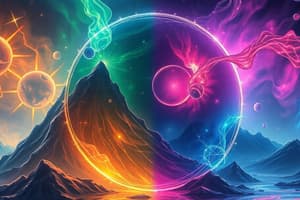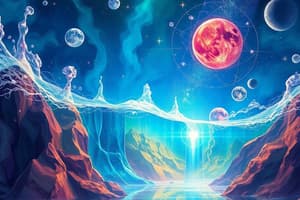Podcast
Questions and Answers
Which of the following is NOT a true statement about the atomic model proposed by J.J. Thomson?
Which of the following is NOT a true statement about the atomic model proposed by J.J. Thomson?
- It depicted electrons embedded within a positively charged sphere.
- It was later replaced by more sophisticated models.
- It suggested that atoms were mostly empty space with a small, dense nucleus. (correct)
- It was based on the results of the cathode ray tube experiment.
Which of the following phase changes involves a release of energy?
Which of the following phase changes involves a release of energy?
- Melting
- Sublimation
- Vaporization
- Freezing (correct)
What is the defining characteristic of a gas?
What is the defining characteristic of a gas?
- No fixed shape or volume, particles are spread far apart (correct)
- Fixed volume but takes the shape of its container
- Particles are tightly packed and vibrate in fixed positions
- Fixed shape and volume
Which scientist's model proposed that electrons orbit the nucleus in specific energy levels?
Which scientist's model proposed that electrons orbit the nucleus in specific energy levels?
Which of the following is an example of deposition?
Which of the following is an example of deposition?
Which of the following is the correct order of the development of atomic models, starting with the earliest?
Which of the following is the correct order of the development of atomic models, starting with the earliest?
What is the primary difference between boiling and evaporation?
What is the primary difference between boiling and evaporation?
According to the atomic theory developed by John Dalton, which of the following statements is true?
According to the atomic theory developed by John Dalton, which of the following statements is true?
What defines the mass number of an atom?
What defines the mass number of an atom?
Which statement correctly describes the number of neutrons in an atom?
Which statement correctly describes the number of neutrons in an atom?
Which of the following best describes metals based on their properties?
Which of the following best describes metals based on their properties?
What is an example of a metalloid?
What is an example of a metalloid?
In a neutral atom, what is the relationship between the atomic number and the number of electrons?
In a neutral atom, what is the relationship between the atomic number and the number of electrons?
Flashcards
Quantum Mechanical Model
Quantum Mechanical Model
Model describing electrons in orbitals as probability regions.
Mass Number (A)
Mass Number (A)
Total number of protons and neutrons in an atomic nucleus.
Atomic Number (Z)
Atomic Number (Z)
Number of protons in the nucleus, also equals electrons in neutral atoms.
Number of Neutrons (N)
Number of Neutrons (N)
Signup and view all the flashcards
Metalloids
Metalloids
Signup and view all the flashcards
Matter
Matter
Signup and view all the flashcards
Solid
Solid
Signup and view all the flashcards
Liquid
Liquid
Signup and view all the flashcards
Gas
Gas
Signup and view all the flashcards
Melting
Melting
Signup and view all the flashcards
Vaporization
Vaporization
Signup and view all the flashcards
Dalton's Model
Dalton's Model
Signup and view all the flashcards
Bohr's Model
Bohr's Model
Signup and view all the flashcards
Study Notes
Matter and its Properties
- Matter is anything with mass and volume, composed of atoms and molecules.
- Three states exist: solid (definite shape and volume), liquid (definite volume, takes container shape), and gas (no definite shape or volume).
States of Matter Examples
- Solid examples: ice, rock, wood.
- Liquid examples: water, oil, juice.
- Gas examples: air, oxygen, helium.
Phase Changes
- Melting: solid to liquid.
- Freezing: liquid to solid.
- Vaporization (boiling/evaporation): liquid to gas.
- Condensation: gas to liquid.
- Sublimation: solid to gas.
- Deposition: gas to solid.
Atomic Theory
- Democritus: proposed the idea of indivisible atoms.
- Dalton: formulated atomic theory; atoms of an element are identical, and atoms combine in whole number ratios.
- J.J. Thomson: discovered the electron, proposed the "plum pudding" model.
- Ernest Rutherford: gold foil experiment, discovered the nucleus, proposed the nuclear model.
- Niels Bohr: model with electrons orbiting in specific energy levels.
- Werner Heisenberg and Erwin Schrödinger: quantum mechanical model, describing electrons with probabilities and wave functions.
Atomic Models
- Dalton: solid sphere.
- Thomson: electrons embedded in a positive sphere.
- Rutherford: small, dense nucleus surrounded by electrons.
- Bohr: electrons in specific energy levels.
- Quantum Mechanical: electrons in orbitals (regions of probability).
Atomic Structure and Calculations
- Mass Number (A): total protons and neutrons.
- Atomic Number (Z): number of protons (and electrons in a neutral atom).
- Neutrons = Mass Number - Atomic Number.
- Example: Carbon-12 (A=12, Z=6) has 6 protons, 6 neutrons, and 6 electrons.
Elements Classification
- Metals: shiny, malleable, ductile, good conductors. Examples: Iron, copper, gold.
- Nonmetals: dull, brittle, poor conductors. Examples: Oxygen, sulfur, nitrogen.
- Metalloids (Semimetals): properties of both metals and nonmetals; often semiconductors. Examples: Silicon, germanium, arsenic. They are located on the periodic table staircase.
Studying That Suits You
Use AI to generate personalized quizzes and flashcards to suit your learning preferences.




